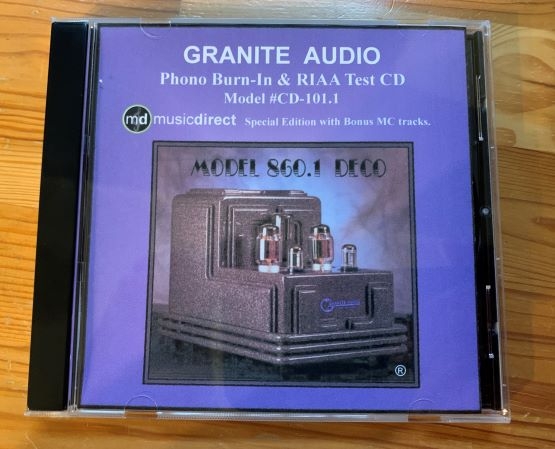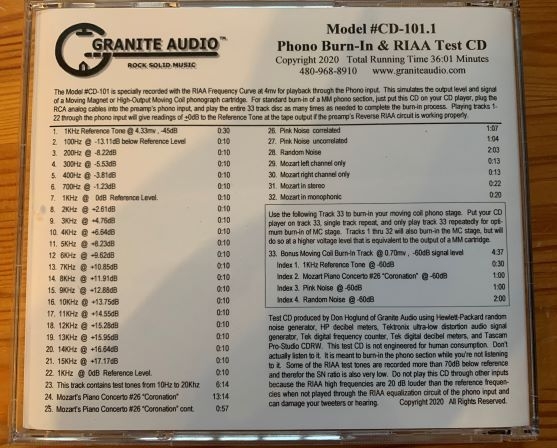Granite Audio Phono Burn-in Cd
How to optimise your system for a new listening season

[ Home | Staff & Contacts | HiFi Playground | Listening tests | DIY & Tweakings | Music & Books ]

Product: Phono stage burn-in CD
Manufacturer: Granite Audio - USA
Recommended Retail Price: 50 US$ at September 2022
Reviewer: Piero Canova -
TNT Italy
Reviewed: September, 2022
Here we are, back from the well-deserved summer holidays or anyway from a season where the climate conditions, at least in the northern hemisphere are favorable for enjoying fresh air and when we had a bit less time for our listening to our hi-fi. I live in a region of Northern Italy where, during the summer,we have very strong thunderstorms. These storms are very common so around mid-July I switch off the complete hi-fi system and I remove the main plug from the wall socket. Also, in this way, I save some mains power but this poses the problem of what to do after a month of silence, to recommission the system.
My system is installed in an underground room with windows, but this poses the problem of excessive humidity during summer when hot and moist air enters from outside and cools down in the room. I had to buy a de-humidifier to avoid this problem but, since most systems are installed close to a wall, the air circulation isn't perfect and with humidity being a continuous risk, I always carry out some remedial work.
The first thing I do is to disconnect all plugs and connectors and clean them with some good quality contact cleaner. It is a bit useless to have the best quality connectors and then leave them to get oxidized, don't you think? There are several products in the market that can be used for this purpose; I personally use the Deoxit Gold from Caig, but I haven't made any serious comparison with other products, so I can't state that this is the best product available. Just use a cloth that doesn't leave a residue and patiently clean them all You will also notice that when reinstalling all connectors or plugs there will be much less friction so you will avoid scratching the plating.
At this point, I connect the main plug to the mains outlet and I switch on all the components. I check that there are no unusual noises and that the turntables and CD spin correctly. I then leave everything on for some hours to let the system warm up correctly without any music playing. Then I put some music on a low volume (usually a CD in repeat mode) to move the coils and suspensions of the speakers. Now, if your system is based on digital sources you should be ready for some serious listening. If your system, like mine, is based on turntables there is still some work to be done. For cartridges and the arm wiring, the best option is to use a test record (I use the Cardas one) to move the suspension of the cartridges. For phono stages, either you continue with the test record, but in this way you will accelerate wear in the stylus of the cartridge or alternatively you can use the Phono Burn-in CD from Granite Audio.
The Model #CD-101.1 from Granite Audio is a CD containing 33 tracks
specifically designed to optimize the burn-in of a phono stage. The first
32 tracks are specifically designed to simulate the output of an MM
cartridge or of a high output MC with an output of 4 mV, while
track 33 with its four sub-sections simulates the output of an MC
cartridge with an output of 0,7mV. Furthermore, the tracks are processed
using an RIAA equalization curve, in the same way records are recorded.

The bass frequencies are attenuated, while high ones are boosted in the same way they are during the recording of a record.Using the CD is very simple: you connect the output of your CD player to the input of the phono stage, insert your CD, and chose the tracks appropriate to your cartridge. Put your CD player in repeat and leave it for a few hours to complete the burn-in process. The combination of Pink Noise, Random Noise and music covering the entire audio spectrum will produce a better and complete burn-in. Some of you might be tempted to replicate this process by using an attenuated signal, but I stress to you the importance of having the RIAA equalization correctly applied. Without it, you will be feeding your phono stage with bass frequencies like 50Hz with a level some 15dB higher than they should be with the serious possibility of overloading your phono stage or damaging the woofers. I can't state here that this is the perfect burn-in process, but certainly it works well, it is easy to use, it saves me many hours of test record playing to perform the burn-in of the phono stages, and, last but not least, considering the cost of an MC cartridge and the expected life of the stylus, allows you to save some serious money.
Once a year an inspection is, in my view, mandatory for your system. In this way, with little expense, you will keep the performance of your system at its best and if you use a tool like the Grantie Audio Phono Burn-in CD it will be much easier. Have a good new listening season!
DISCLAIMER. TNT-Audio is a 100% independent magazine that neither accepts advertising from companies nor requires readers to register or pay for subscriptions. If you wish, you can support our independent reviews via a PayPal donation. After publication of reviews, the authors do not retain samples other than on long-term loan for further evaluation or comparison with later-received gear. Hence, all contents are written free of any “editorial” or “advertising” influence, and all reviews in this publication, positive or negative, reflect the independent opinions of their respective authors. TNT-Audio will publish all manufacturer responses, subject to the reviewer's right to reply in turn.
© Copyright 2022 Piero Canova - piero@tnt-audio.com - www.tnt-audio.com
[ Home | Staff & Contacts | HiFi Playground | Listening tests | DIY & Tweakings | Music & Books ]